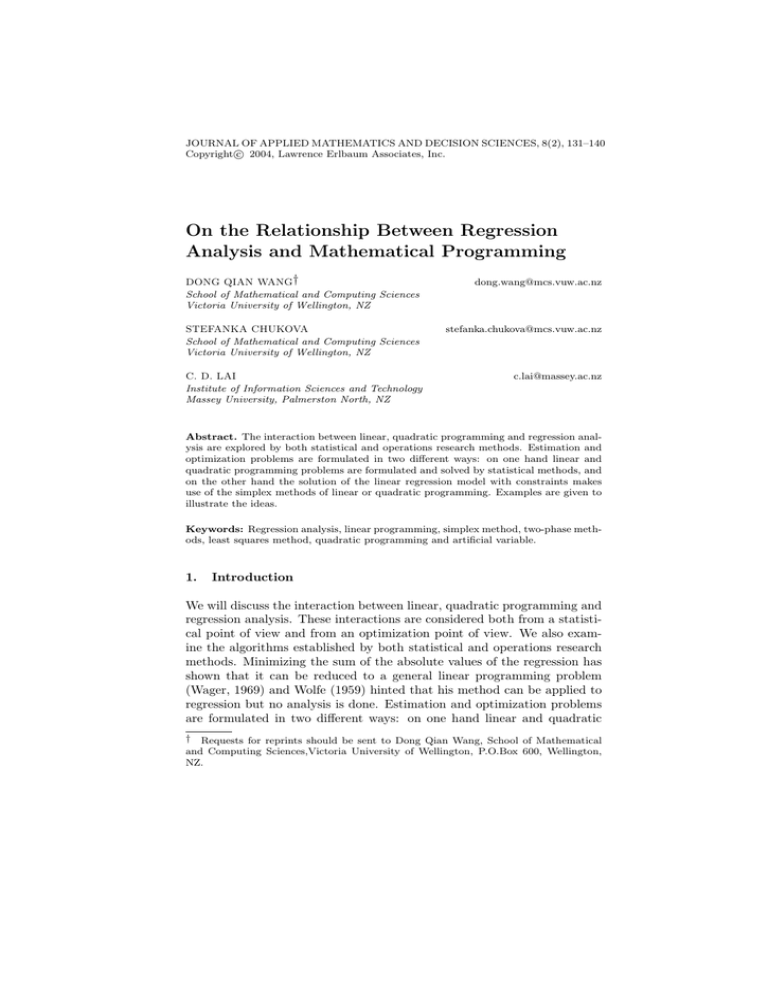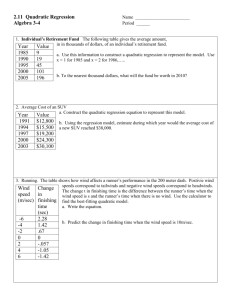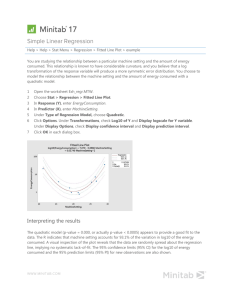Document 10908894
advertisement

JOURNAL OF APPLIED MATHEMATICS AND DECISION SCIENCES, 8(2), 131–140
c 2004, Lawrence Erlbaum Associates, Inc.
Copyright
On the Relationship Between Regression
Analysis and Mathematical Programming
DONG QIAN WANG†
School of Mathematical and Computing Sciences
Victoria University of Wellington, NZ
dong.wang@mcs.vuw.ac.nz
STEFANKA CHUKOVA
School of Mathematical and Computing Sciences
Victoria University of Wellington, NZ
stefanka.chukova@mcs.vuw.ac.nz
C. D. LAI
Institute of Information Sciences and Technology
Massey University, Palmerston North, NZ
c.lai@massey.ac.nz
Abstract. The interaction between linear, quadratic programming and regression analysis are explored by both statistical and operations research methods. Estimation and
optimization problems are formulated in two different ways: on one hand linear and
quadratic programming problems are formulated and solved by statistical methods, and
on the other hand the solution of the linear regression model with constraints makes
use of the simplex methods of linear or quadratic programming. Examples are given to
illustrate the ideas.
Keywords: Regression analysis, linear programming, simplex method, two-phase methods, least squares method, quadratic programming and artificial variable.
1.
Introduction
We will discuss the interaction between linear, quadratic programming and
regression analysis. These interactions are considered both from a statistical point of view and from an optimization point of view. We also examine the algorithms established by both statistical and operations research
methods. Minimizing the sum of the absolute values of the regression has
shown that it can be reduced to a general linear programming problem
(Wager, 1969) and Wolfe (1959) hinted that his method can be applied to
regression but no analysis is done. Estimation and optimization problems
are formulated in two different ways: on one hand linear and quadratic
† Requests for reprints should be sent to Dong Qian Wang, School of Mathematical
and Computing Sciences,Victoria University of Wellington, P.O.Box 600, Wellington,
NZ.
132
D. Q. WANG, S. CHUKOVA AND C. D. LAI
programming problems are formulated and solved by statistical methods,
and on the other hand the solution of the linear regression model with
constraints makes use of the simplex methods of linear or quadratic programming. Examples are given to show some practical applications of the
methods. It is our aim that students taking a linear or non-linear programming (NLP) courses as well as a course in linear models will now realize
that there is a definite connection between these problems.
1.1.
Regression models
Consider the linear regression (LR) model with nonnegative constraints
Y (β) = Xβ + subject to β ≥ 0,
(1)
where Y ∈ Rn represents the vector of responses, X is an n × p design
matrix, β ∈ Rp represents the unknown parameters of the model and
β ≥ 0 means that all the elements in the vector are non-negative, and represents the random error term of the LR model.
A general linear regression model (1) with inequality constraints (LRWC)
and nonnegative variables is given as follows:
subject to
Y (β) = Xβ + ε
Aβ ≥ C
β ≥ 0,
(2)
where β ∈ Rp is the unknown vector; Xn×p (n ≥ p) and As×p (s ≤ p) are
constant matrices, Yn×1 , Cs×1 , and εn×1 are column vectors, ε ∼ N (0, σ 2 I)
; X T X ≥ 0 and rank(A) = s. The solution of LRWC is a subject of
the Karush-Kuhn-Tucker theorem. The subsequent algorithms for solving
LRWC are discussed in Lawson and Hanson (1974) and Whittle (1971).
1.2.
Mathematical programming
Due to the fact that max{f (x)} = min{−f (x)}, we will focus our attention only on minimization problems. A primal linear programming (LP)
problem with nonnegative solution can be formulated as follows:
minimize L(β) = bT β
subject to Gβ ≥ f
β ≥ 0,
(3)
RELATIONSHIP BETWEEN REGRESSION AND PROGRAMMING
133
where β is the unknown vector, 0 6= bT ∈ Rp , f T ∈ Rm and Gm×p are
known constant vectors and a matrix, respectively.
A quadratic programming (QP) problem in which all the variables must
be nonnegative is formulated as follows:
minimize Z0 (β) = bT β + β T Dβ
subject to Aβ ≥ C
β ≥ 0,
(4)
where As×p , (s ≤ p), Dp×p are matrices; Cs×1 , βp×1 and bp×1 are column
vectors, rank (A) = s ≤ p and D is symmetric and positive definite matrix.
In the next section, we further explore the relationships between the
above four models. The aim in this note is to provide a strong link and
algorithms between these concepts. In fact they are equivalent in some
cases. Parameter estimates of models (1) and (2) are obtained by the
simplex method and the Karush-Kuhn-Tucker theorem. The optimization problems of models (3) and (4) are restated and solved by statistical
methods.
2.
Solving Linear Regression Model by Using Mathematical Programming
Consider given n observations {(xi , yi ), i = 1, 2, ..., n}. The linear regression model (1) with p = 2, can be rewritten as Yi = β0 + β1 xi + i and
β = (β1 , β2 )T ≥ 0. Using the least squares method to estimate parameters
β0 and β1 , we need to minimize g(β), i.e
minimize
g(β) =
n
X
(yi − β0 − β1 xi )2
i=1
subject to
β ≥ 0.
The associated system of normal equations is given as follows:
nβ0 + β1
n
X
xi −
i=1
β0
n
X
i=1
xi + β1
n
X
i=1
x2i −
n
X
yi = 0,
i=1
n
X
xi yi = 0.
i=1
Therefore, model (1) is equivalent to the following mathematical
programming problem:
134
D. Q. WANG, S. CHUKOVA AND C. D. LAI
minimize
g(β) =
n
X
(yi − β0 − β1 xi )2
i=1
n
X
subject to
nβ0 + β1
n
X
xi =
i=1
β0
n
X
xi + β1
i=1
yi
(5)
i=1
n
X
x2i =
i=1
n
X
xi yi
i=1
β ≥ 0.
We will use the phase I in the two-phase version of the simplex method to
solve (5). The problem to be solved by phase I is
Y0I = −R1 − R2
nβ0 + c1 β1 + R1 = c2
c1 β0 + b1 β1 + R2 = b2
β ≥ 0 and R1 , R2 ≥ 0;
maximize
subject to
(6)
where R1 and R2 are artificial variables. The optimization problem (6) can
be rewritten as
Y0I = (n + c1 )β0 + (b1 + c1 )β1 − (b2 + c2 )
nβ0 + c1 β1 + R1 = c2
(7)
c1 β0 + b1 β1 + R2 = b2
βi ≥ 0 and Ri ≥ 0, i = 1, 2;
P
P
P 2
P
where c1 =
xi , c2 =
y i , b1 =
xi , and b2 =
xi yi . The initial
values are summarized in the Table 1.
maximize
subject to
Table 1. The initial values of problem (7).
BV
Y0I
β0
−n − c1
β1
−b1 − c1
R1
R2
0
0
RHS
−b2 − c2
R1
n
c1
1
0
c2
R2
c1
b1
0
1
b2
Bearing in mind that the solution of the LR problem is actually the
solution of the corresponding system of normal equations, it is now easy
135
RELATIONSHIP BETWEEN REGRESSION AND PROGRAMMING
to see that problem (7) is equivalent to solving related the LR problem
(1). Hence we can obtain the optimal solution for model (1) by using the
simplex method for problem (7) with the initial values in Table 1. The
above approach can be applied for solving linear regression model (1) with
p > 2, i.e.,
(1)
(2)
(p)
Yi = β0 + β1 xi + β2 xi + ... + βp xi
subject to β ≥ 0.
+ i
(8)
Next, we will illustrate the above ideas by an example.
Example 2.1: (Rencher, 2000, p113-114) The exam scores y and homework scores x (average value) for 18 students in a statistics class were as
follows
47
90
66
98
x
74
67
y
75
66
P
From P
the given data set, we obtain:
P 2 c1 = xi = 1, 045, c2 = yi = 1, 105,
b2 =
xi yi = 81, 195, b1 =
xi = 80, 199 and n = 18. Hence, Table 1
becomes
x
y
96
95
93
90
BV
Y0I
77
80
18
0
β0
0
0
86
95
β1
0
0
0
35
78
79
30
50
P
64
77
59
72
89
72
77
55
R1
R2
RHS
Ratio
-1063
-81244
0
0
-82300
–
R1
18
1045
1
0
1105
1.057
R2
1045
80199
0
1
81195
1.012
Using the simplex method, the optimal table is obtained in two iterations
as:
BV
β0
β1
RHS
Y0I
0
0
β0
1
0
10.727
–
β1
0
1
0.873
–
0
Ratio
–
Therefore, β̂0 = 10.727, β̂1 = 0.873 and a fitted linear regression line is
given by ŷ = 10.727 + 0.873x.
136
3.
D. Q. WANG, S. CHUKOVA AND C. D. LAI
Solving the Least Squares Problem With Constraints Using
NLP Methods
Using the least squares method to model (2) we obtain a general regression problem:
min Z(β) = (Y − Xβ)T (Y − Xβ)
subject to Aβ ≥ C
β ≥ 0.
(9)
Problem (9) is a simultaneous quadratic programming problem and thus
it can be solved by using Wolfe’s method based on Karush-Kuhn-Tucker
conditions. Rewriting problem (9) as a quadratic programming problem
leads to:
min Z0 (β) = a + nβ02 + b1 β12 − 2c2 β0 − 2b2 β1 + 2c1 β0 β1
subject to Aβ ≥ C
(10)
β ≥ 0,
P 2
P
P
where,
yi , c1 =
xi , c2 =
yi ,
P as in the previous
P 2 example, a =
b2 = xi yi and b1 = xi .
Example 3.1: Use the given set of data to evaluate the parameters of a
simple linear regression model with additional restrictions imposed on the
parameters of the model, i.e.,
2β0 + β1 ≥
−2β0 + β1 ≥
βi ≥
x
y
.055
90
.091
97
650
500
0
i = 1, 2.
.138
107
.167
124
.182
142
.211
150
.232
172
.248
189
.284
209
.351
253
From
the given dataPset,we can calculate
259993, c1 =
P
P the values of a = P
xi = 1.959, c2 =
yi = 1533, b2 =
xi yi = 341.68 b1 =
x2i = .4551
and n = 10. Parameter estimates of the model obtained by the standard
regression technique are β0 = 39.6484 and β1 = 580.151.
Let us solve the same problem by employing nonlinear programming
ideas. Firstly, we have to rewrite the problem in the form of quadratic
programming by using the previously calculated values of b1 , b2 , c1 and c2 .
We have:
RELATIONSHIP BETWEEN REGRESSION AND PROGRAMMING
137
min Z0 = 259993 + 10β02 + .4551β12 − 3066β0 − 683.36β1 + 3.918β0 β1
subject to
2β0 + β1 ≥ 650
−2β0 + β1 ≥ 500
βi ≥ 0
i = 1, 2.
Then, solving the above quadratic programming problem with Wolfe’s
method confirms the optimal values of β0 = 39.6484 and β1 = 580.151.
4.
Solving QP Problem Using the Least Squares Method
The relationship between the quadratic programming (4) and the least
squares method (9) is studied by Wang, Chukova and Lai (2003),
Theorem 1: The relationship of QP (4) and LS (9) is given by
Z0 (β) =
1 T −1
b D b + Z(β),
4
where X is a real upper triangular matrix with positive diagonal elements
satisfying X T X = D and Y = − 12 (X T )−1 b.
Hence, minimizing Z0 is equivalent to minimizing Z(β). Moreover, when
b = 0, we have
Z0 (β) = Z(β) = (Y − Xβ)T (Y − Xβ).
Let us consider the least squares problem similar to (9) where all the
constraints are in the form of equality, i.e Aβ = C. Using the Lagrangian
method, we obtain the corresponding normal equation:
Aβ = C
AT λ + X T Xβ = X T Y.
(11)
Theorem 2: Let β̂ ∗ be the solution of (11) and β̂0 be the solution of
linear regression model with no constraints. Then, the relationship between
β̂ ∗ and β̂0 is:
β̂ ∗ = [I − (X X )−1 AT H −1 A]β̂0 + (X T X)−1 AT H −1 C
where H = A(X T X)−1 AT is a hat matrix (Sen 1990).
Based on Theorem 1 and Theorem 2, Wang, Chukova and Lai (2003)
developed a stepwise algorithm for reducing and solving QP problem (4)
138
D. Q. WANG, S. CHUKOVA AND C. D. LAI
with regression analysis. The following example illustrates the algorithm.
Example 4.1: Consider
−2x1 − 3x2 + x21 + x22 + x1 x2
2x1 + 2x2 ≤ 2
3x1 − 2x2 ≥ 1
xi ≥ 0
i = 1, 2.
min Z0 =
subject to
The solution to this QP by using Wolfe’s method is found to be Z T =
(x1 , x2 ) = ( 43 , 58 ). Let us apply our algorithm for reducing the above QP
to LS. We have
x1
x1
1 1
min Z0 = (−2 − 3)
+ (x1 x2 ) 1 2
x2
x2
2 1
subject to
−1 −2
3 −2
x1
x2
≥
−2
1
xi ≥ 0, i = 1, 2.
and
The above is a matrix representation of model (4). Let
A=
−1 −2
3 −2
=
aT1
aT2
, C=
−2
1
,
and
D=
1
1
2
1
2
1
, b=
−2
−3
.
1. Find the matrices X and Y and convert a QP problem to a LS problem.
X = Choleski(D) =
1
1
2
0 .866
and
1
Y = − (X T )−1 b =
2
1, 1.1547
T
.
2
2. Solve LS min Q(β) = (Y − Xβ)T (Y − Xβ) over R+
.
T
4
1
∗
.
The solution is β = 3 , 3
139
RELATIONSHIP BETWEEN REGRESSION AND PROGRAMMING
3. Verify whether Aβ ∗ ≥ C. In this case both conditions in model (4) are
not satisfied. Thus we have to solve the following two problems:
•
First, we solve
min
subject
to
= (Y − Xβ (1) )T (Y − Xβ (1) )
Q(β (1) )
(1)
(1)
−β1 − 2β2
= −2
(1)
βi
≥
0, i = 1, 2.
and obtain
β (1) =
•
5
6
1
3,
T
.
Then solve
min
subject
to
= (Y − Xβ (2) )T (Y − Xβ (2) )
Q(β (2) )
(2)
(2)
3β1 − 2β2
(2)
βi
=1
≥
0, i = 1, 2.
and obtain
β (2) =
.894739, .8421085
T
.
4. Verify whether Aβ (1) ≥ C or Aβ (2) ≥ C.
It is easy to check that the constraint Aβ (i) ≥ C , for i = 1, 2 is not
satisfied. Hence, we solve for
min
subject
to
= (Y − Xβ (1,2) )T (Y − Xβ (1,2) )
Q(β (1,2) )
(1,2)
(1,2)
−β1
− 2β2
(1,2)
(1,2)
3β1
− 2β2
(1,2)
βi
= −2
=
1
≥
0,
i = 1, 2,
which gives
β (1,2) =
3
4,
5
8
T
.
5. Verify whether Aβ (1,2) ≥ C.
The constraint Aβ (1,2) ≥ C is satisfied. Thus, the the optimal solution
is
T
.
β̂ = β (1,2) = 43 , 58
The above solution confirms the previous result obtained by Wolfe’s method.
140
5.
D. Q. WANG, S. CHUKOVA AND C. D. LAI
Conclusions
A linear regression model is solved by two-phase version of the simplex
method. A statistical algorithm to solve the quadratic programming problem is proposed. In comparison with the nonlinear programming methods
for solving QP, our algorithm has the following advantages:
(a) Statistical courses often form the core portion for most degree programs at bachelor level. The algorithm based on basic statistical concepts
is easy to understand, learn and apply.
(b) Some of the steps of the algorithm are included as built-in functions or
procedures in many of the commonly used software packages like MAPLE,
MATHEMATICA and so on.
(c) The algorithm avoids the usage of slack and artificial variables.
References
1. W. Kaplan. Maximum and minima with applications, practical optimization and
duality. John Wiley and Sons Ltd, 1999.
2. C. L. Lawson and R. J. Hanson. Solving least squares problems. John Wiley and
Sons Ltd, 1974.
3. A. C. Rencher. Linear models in statistics. Wiley-Interscience Publications, John
Wiley and Sons Ltd, 2000.
4. A. N. Sadovski. L1-norm fit of a straight line: algorithm AS74. Applied Statistics,
23: 244-248, 1974.
5. A. Sen and M. Srivastava. Regression Analysis. Spring - Verlag, 1990.
6. D. Q. Wang, S. Chukova and C. D. Lai. Reducing quadratic programming problem to regression analysis: stepwise algorithm. To appear in European Journal of
Operational Research, 2003.
7. P. Whittle. Optimization under constraints. Wiley-Interscience Publications, John
Wiley and Sons Ltd, 1971.
8. W. L. Winston. Operations research, with applications and algorithms. Duxbury
Press, 1994.





